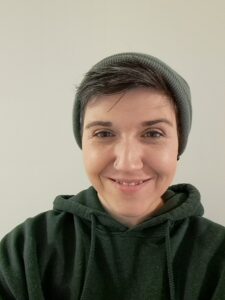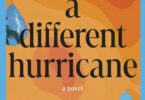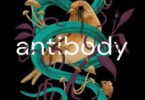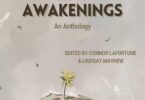Jade Wallace, Anomia (Palimpsest Press, 2024), 230 pp., $21.95.
Readers of Jade Wallace’s poetry will recognize a familiar vibrancy of language and surrealism in Anomia. Sitting comfortably in the liminal space between genres, Wallace’s debut novel defies easy categorization. Anomia is a lush and frequently witty meditation on community, love, memory, and found family that adheres to a rigidity of form while employing precise, affective language to illustrate the intimate connection between grief, loss, healing, and community.
The story is set against the backdrop of a small town called Euphoria. The fragmented narrative skips between three central plots that eventually weave together. First, there is Fir, a middle-aged video store worker investigating the disappearance of their lover Blue and Blue’s spouse, Culver. Assisting Fir in the search for the missing couple is Fir’s friend, Fain. The second narrative follows Limn and Mal, teenagers who suspect their neighbour of harbouring a dark secret. The third plot centers on Slip, an old person who discovers a scattering of bones in the mysterious wooded area near the trailer park.
“A town that seemed displaced in both space and time” (14-15), Euphoria and its inhabitants exist in a world that is simultaneously reassuringly familiar and unnervingly alien. Highways, trailer parks, and teenagers who hang out and watch horror movies are all recognizably mundane, but the town is void of specific geographic or temporal marks. There are no cell phones in Euphoria, it seems. And the town lacks any distinct landscape features that would allow it to be placed in a specific part of North America. Instead, Euphoria is a place that feels more like the memory of a town than an actual physical location. Euphoria’s sole unique physical feature is the Unwood, a forest that borders the town’s trailer park. The Unwood contains a vast clearing with thick underbrush that has fed local rumours and speculation that it is “one of those rare, liminal spaces where people go to die” (47). It is in the Unwood that the narrative begins, with Slip’s first discovery of the bones.
Wallace’s novel effectively balances dense, lyrical prose with a well-paced plot. Though Anomia is undoubtedly literary in its ambitions, it is also a mystery. Self-consciously incorporating elements of true crime and horror, the central narrative is driven by the mystery of Blue and Culver’s disappearance and Fir’s tireless search for the truth.
Just as “on their own, the bones cannot snap together to form a skeleton” (13), Slip cannot piece together the truth of the bones by themselves. This is a fitting metaphor for the fragmented narrative of the novel itself. For as much as the stories of the teenagers, Slip, and Fir are fragmented, they are also deeply interconnected. It is only with the help of Slip and the teens that Fir is able to find out what happened to their lover. Similarly, it is only with Fir’s help that Slip and the teenagers learn who the bones may have belonged to in life. Alone, each narrative is incomplete, a small piece of the larger whole. The same is true of the characters themselves, who struggle with feelings of isolation and loneliness but ultimately find connection and comfort in one another.
Throughout the novel, there is a recurring motif of love and community growing out of grief and loss. The relationship between Fir and Fain deepens when Fir accepts Fain’s help in the search for Blue. Fir permits themselves to be vulnerable and rely on Fain, even though doing so feels unfamiliar. After Fain invites an emotionally distraught Fir to spend the night in a purely platonic manner, Fir is unable to sleep, having “nearly forgotten the reassuring discomfort of sleeping beside someone” (54). Similarly, Slip is a loner in the town until they discover the bones, and it is by first seeking companionship from the bones that they are led to find community with the living.
Perhaps the most immediately striking feature of Wallace’s novel is not its content but its form. In Euphoria, no one is explicitly gendered. The text lacks first-person pronouns altogether, and individual characters are referred to simply by their names. The pronoun “they” is only used in its plural form. For example, we quickly learn that the title of the opening section, “They,” refers not to any living character in the text, but to the bones. Later, after Slip has brought the bones in from the Unwood and cleaned them, “Slip decides that it is better to presume a plurality than a singularity,” and “the bones become The Corpses and Slip begins to speak to them” (13).
The text emphasizes the physical reality of life and death with its focus on decaying bodies and the breakdown of organic matter. The narrator tells us that “If the human mind were a place, it would be a body of water, immeasurably deep, where fish, aquatic plants, and microorganisms multiply too quickly to be tracked… And the rock, slowly atomizing into silt and sand, is dusted with the remains of decaying life forms, like a forest floor covered with shed fur and fallen leaves” (93). Here, human thoughts are like fish and other aquatic creatures “multiplying too quickly to be tracked,” but for all the life it contains, the “human mind” is also a graveyard of sorts, littered with “decaying life forms” and the physical remnants of death.
It isn’t just organic matter that breaks down. Human relationships are also prone to decay. The distance between Slip and everyone else in the community is described as a slow decomposition: “Without children, without a living spouse, siblings, or parents, and with most acquaintances long since dead or their names forgotten, nearly everyone Slip meets these days is a stranger” (9). It is out of this death that connections form and new life begins. Blue and Fir’s romance is only able to take shape as Blue’s marriage to Culver breaks down. The connection between the lovers grows through sharing their experiences of loss, “After the showing of wounds, neither of them flinched. They turned toward one another instead of away” (101-102). For as much as the novel demonstrates the inevitability of loss, it also emphasizes our innate need for community and belonging. We must depend on others – even if that means we will one day grieve.
Just as it rejects the gender binary, Anomia also eschews a binary view of physical and spiritual wellbeing by suggesting that physical contentment, vulnerability, found family, and genuine connection with others can not only be found in the ashes of grief and loss but, even further, depend upon the shared experience of loss, hurt, and healing. The rejection of binaries, expressed through both the content of the novel as well as the physical limitations of its narrative form, is what propels the story forward. To put it differently, Anomia demonstrates that community does not heal us. Rather, it is through collective healing and vulnerability that we form community.
 Shannon Page (they/them) is a writer, film critic, and educator living on the unceded territory of the Musqueam, Squamish, and Tsleil-Waututh peoples. Their writing has appeared in Plenitude Magazine, THIS Magazine, Grain, Foglifter, and elsewhere.
Shannon Page (they/them) is a writer, film critic, and educator living on the unceded territory of the Musqueam, Squamish, and Tsleil-Waututh peoples. Their writing has appeared in Plenitude Magazine, THIS Magazine, Grain, Foglifter, and elsewhere.







